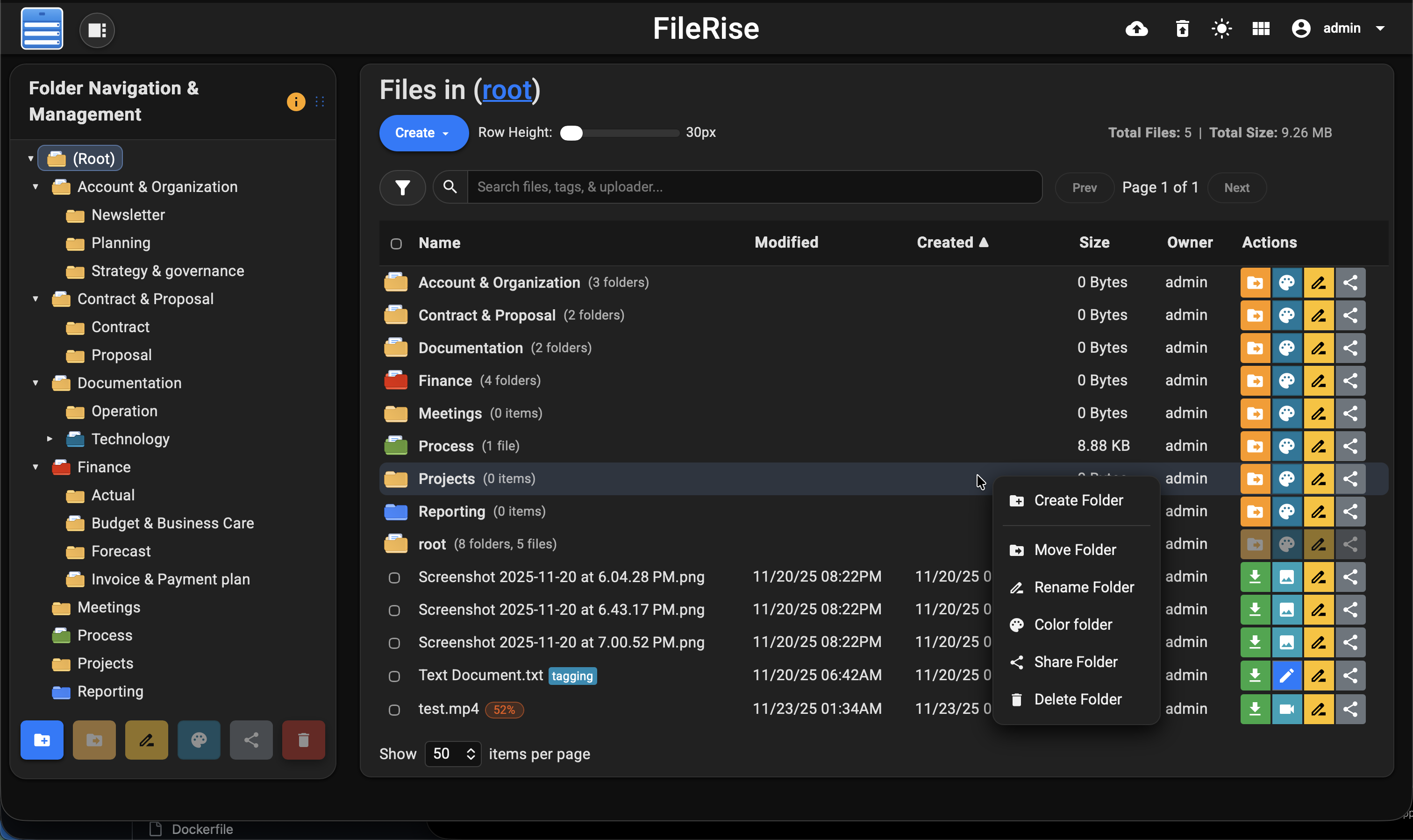FileRise is a modern, self-hosted web file manager / WebDAV server.
Drag & drop uploads, ACL-aware sharing, OnlyOffice integration, and a clean UI — all in a single PHP app that you control.
- 💾 Self-hosted “cloud drive” – Runs anywhere with PHP (or via Docker). No external DB required.
- 🔐 Granular per-folder ACLs – View / Own / Upload / Edit / Delete / Share, enforced across UI, API, and WebDAV.
- 🔄 Fast drag-and-drop uploads – Chunked, resumable uploads with pause/resume and progress.
- 🌳 Scales to huge trees – Tested with 100k+ folders in the sidebar tree.
- 🧩 ONLYOFFICE support (optional) – Edit DOCX/XLSX/PPTX using your own Document Server.
- 🌍 WebDAV – Mount FileRise as a drive from macOS, Windows, Linux, or Cyberduck/WinSCP.
- 🎨 Polished UI – Dark/light mode, responsive layout, in-browser previews & code editor.
- 🔑 Login + SSO – Local users, TOTP 2FA, and OIDC (Auth0 / Authentik / Keycloak / etc.).
- 👥 User groups & client portals (Pro) – Group-based ACLs and brandable client upload portals.
Full list of features available at Full Feature Wiki
💡 Looking for FileRise Pro (brandable header, user groups, client upload portals, license handling)? Check out filerise.net – FileRise Core stays fully open-source (MIT).
- 🚀 Live demo: Demo (username:
demo/ password:demo) - 📚 Docs & Wiki: Wiki
- 🐳 Docker image: Docker
- 📝 Changelog: Changes
FileRise turns a folder on your server into a web‑based file explorer with:
- Folder tree + breadcrumbs for fast navigation
- Multi‑file/folder drag‑and‑drop uploads
- Move / copy / rename / delete / extract ZIP
- Public share links (optionally password‑protected & expiring)
- Tagging and search by name, tag, uploader, and content
- Trash with restore/purge
- Inline previews (images, audio, video, PDF) and a built‑in code editor
Everything flows through a single ACL engine, so permissions are enforced consistently whether users are in the browser UI, using WebDAV, or hitting the API.
The easiest way to run FileRise is the official Docker image.
docker run -d --name filerise -p 8080:80 -e TIMEZONE="America/New_York" -e PERSISTENT_TOKENS_KEY="change_me_to_a_random_string" -v ~/filerise/uploads:/var/www/uploads -v ~/filerise/users:/var/www/users -v ~/filerise/metadata:/var/www/metadata error311/filerise-docker:latestThen visit:
http://your-server-ip:8080
On first launch you’ll be guided through creating the initial admin user.
More Docker options (Unraid, docker‑compose, env vars, reverse proxy, etc.) Install & Setup nginx FAQ See the Docker repo: docker repo
Prefer bare‑metal or your own stack? FileRise is just PHP + a few extensions.
Requirements
- PHP 8.3+
- Web server (Apache / Nginx / Caddy + PHP‑FPM)
- PHP extensions:
json,curl,zip(and usual defaults) - No database required
Steps
-
Clone or download FileRise into your web root:
git clone https://github.com/error311/FileRise.git
-
Create data directories and set permissions:
cd FileRise mkdir -p uploads users metadata chown -R www-data:www-data uploads users metadata # adjust for your web user chmod -R 775 uploads users metadata
-
(Optional) Install PHP dependencies with Composer:
composer install
-
Configure PHP (upload limits / timeouts) and ensure rewrites are enabled.
- Apache: allow
.htaccessor copy its rules into your vhost. - Nginx/Caddy: mirror the basic protections (no directory listing, block sensitive files).
- Apache: allow
-
Browse to your FileRise URL and follow the admin setup screen.
For detailed examples and reverse proxy snippets, see the Installation page in the Wiki.
Once enabled in the Admin panel, FileRise exposes a WebDAV endpoint (e.g. /webdav.php). Use it with:
- macOS Finder – Go → Connect to Server →
https://your-host/webdav.php/ - Windows File Explorer – Map Network Drive →
https://your-host/webdav.php/ - Linux (GVFS/Nautilus) –
dav://your-host/webdav.php/ - Clients like Cyberduck, WinSCP, etc.
WebDAV operations honor the same ACLs as the web UI.
See: WebDAV
If you run an ONLYOFFICE Document Server you can open/edit Office documents directly from FileRise (DOCX, XLSX, PPTX, ODT, ODS, ODP; PDFs view‑only).
Configure it in Admin → ONLYOFFICE:
- Enable ONLYOFFICE
- Set your Document Server origin (e.g.
https://docs.example.com) - Configure a shared JWT secret
- Copy the suggested Content‑Security‑Policy header into your reverse proxy
Docs: ONLYOFFICE
- FileRise is actively maintained and has published security advisories.
- See SECURITY.md and GitHub Security Advisories for details.
- To upgrade:
- Docker:
docker pull error311/filerise-docker:latestand recreate the container with the same volumes. - Manual: replace app files with the latest release (keep
uploads/,users/,metadata/, and your config).
- Docker:
Please report vulnerabilities responsibly via the channels listed in SECURITY.md.
- 🧵 GitHub Discussions & Issues: ask questions, report bugs, suggest features.
- 💬 Unraid forum thread: for Unraid‑specific setup and tuning.
- 🌍 Reddit / self‑hosting communities: occasional release posts & feedback threads.
Contributions are welcome — from bug fixes and docs to translations and UI polish.
See CONTRIBUTING.md for guidelines.
If FileRise saves you time or becomes your daily driver, a ⭐ on GitHub or sponsorship is hugely appreciated:
- ❤️ GitHub Sponsors
- ☕ Ko‑fi
FileRise Core is released under the MIT License – see LICENSE.
It bundles a small set of well‑known client and server libraries (Bootstrap, CodeMirror, DOMPurify, Fuse.js, Resumable.js, sabre/dav, etc.).
All third‑party code remains under its original licenses.
See THIRD_PARTY.md and the licenses/ folder for full details.









